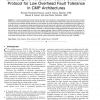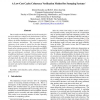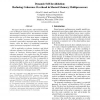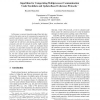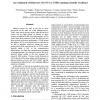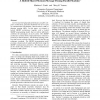127
click to vote
HPCA
2011
IEEE
14 years 4 months ago
2011
IEEE
Future CMPs will combine many simple cores with deep cache hierarchies. With more cores, cache resources per core are fewer, and must be shared carefully to avoid poor utilization...
116
click to vote
ASPLOS
2011
ACM
14 years 4 months ago
2011
ACM
The adoption of transactional memory is hindered by the high overhead of software transactional memory and the intrusive design changes required by previously proposed TM hardware...
122
Voted
ISCA
2011
IEEE
2011
IEEE
Increasing the effectiveness of directory caches by deactivating coherence for private memory blocks
14 years 4 months ago
To meet the demand for more powerful high-performance shared-memory servers, multiprocessor systems must incorporate efficient and scalable cache coherence protocols, such as thos...
132
click to vote
TPDS
2008
15 years 48 min ago
2008
It is widely accepted that transient failures will appear more frequently in chips designed in the near future due to several factors such as the increased integration scale. On th...
141
click to vote
DSD
2008
IEEE
15 years 2 months ago
2008
IEEE
Due to modern technology trends such as decreasing feature sizes and lower voltage levels, fault tolerance is becoming increasingly important in computing systems. Shared memory i...
123
Voted
HIPEAC
2010
Springer
15 years 2 months ago
2010
Springer
Abstract. Customizable processors augmented with application-specific Instruction Set Extensions (ISEs) have begun to gain traction in recent years. The most effective ISEs include...
148
Voted
ISCA
1995
IEEE
15 years 4 months ago
1995
IEEE
This paper introduces dynamic self-invalidation (DSI), a new technique for reducing cache coherence overhead in shared-memory multiprocessors. DSI eliminates invalidation messages...
104
Voted
ANSS
1995
IEEE
15 years 4 months ago
1995
IEEE
In this paper we present simulation algorithmsthat characterize the main sources of communication generated by parallel applications under both invalidate and updatebased cache co...
100
Voted
DSD
2009
IEEE
15 years 4 months ago
2009
IEEE
Modern systems are able to put two or more processors on the same die (Chip Multiprocessors, CMP), each with its private caches, while the last level caches can be either private ...
108
Voted
ICPP
1993
IEEE
15 years 4 months ago
1993
IEEE
Current and emerging high-performance parallel computer architectures generally implement one of two types of communication mechanisms: shared memory (SM) or message passing (MP)....

